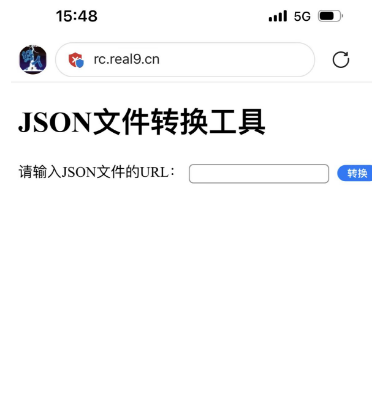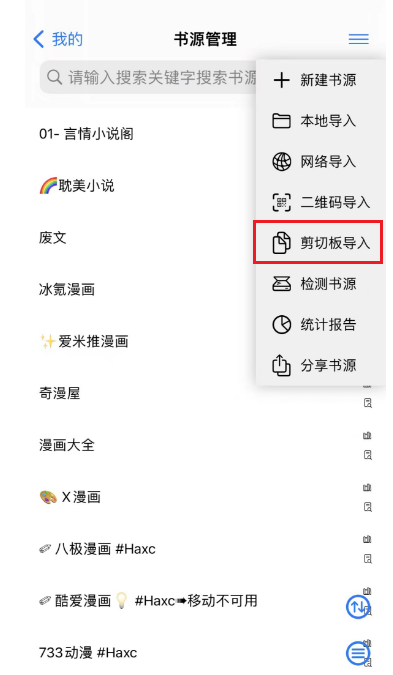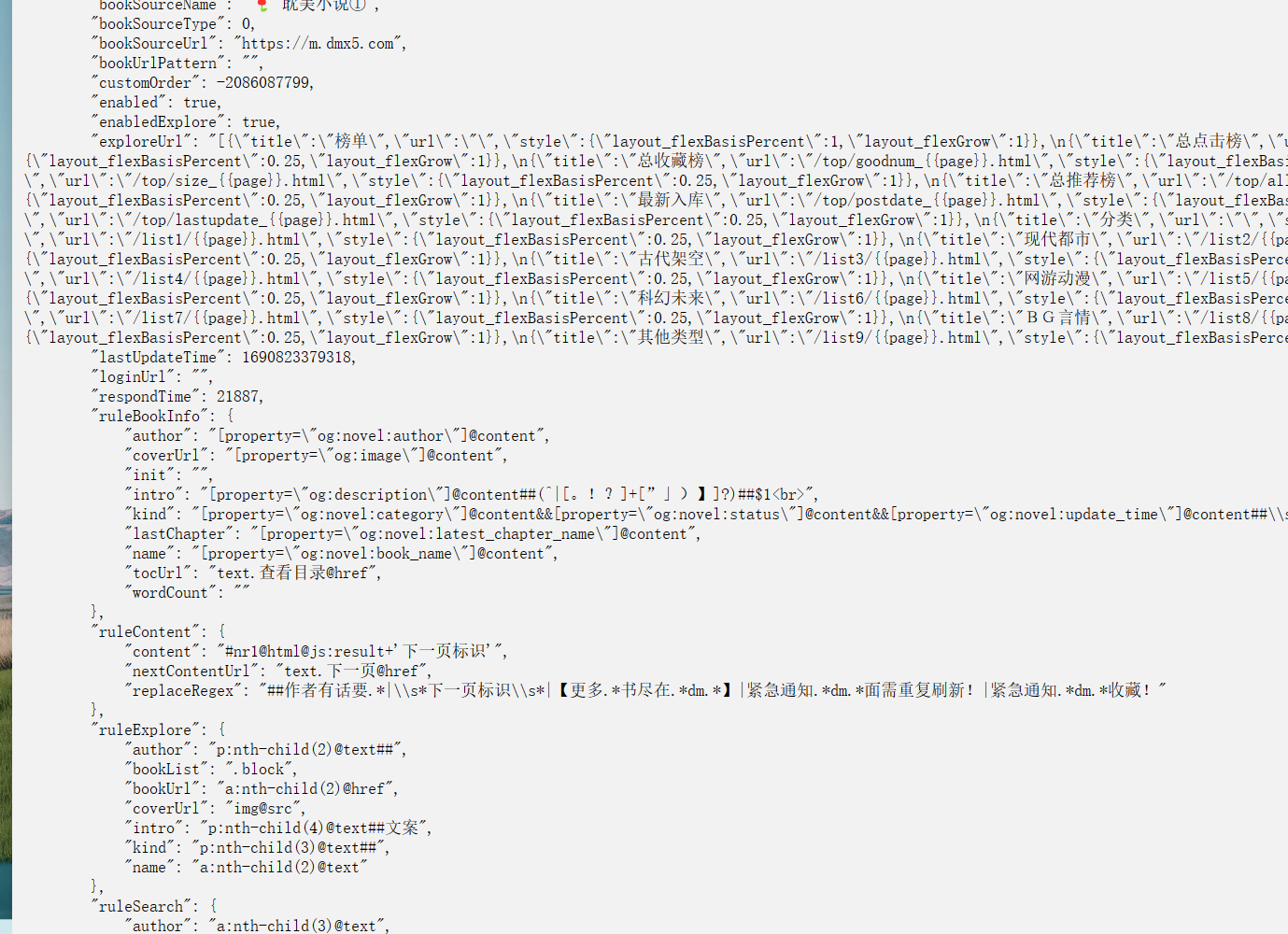IOS看书最终选择|源阅读转换|开源阅读|IOS自签
环境:IOS想使用 换源阅读
问题:换新手机,源阅读下架后,没有好的APP阅读小说
解决办法:自签APP + 转换源仓库书源
最终预览 :https://rc.real9.cn/
背景:自从我换了新iPhone手机,就无法使换源阅读了,于是我自用上,结果发现现在的书源发展的很快,旧版本的源阅读APP部分书源的语法不支持,于是我反复总结对比,写了一个自动转换的python程序,如上链接
解决过程:自签APP+转换书源
文章目录
- 1.下载 ipa:
- 2.自签IPA:
- 3.转换书源
- 3.1 获得书源
- 3.2 转换规则
- 3.3 转换书源
- 4.在线转换
- 4.1 web版源代码:
- 4.2 我还写了个docker版本的
1.下载 ipa:
下载地址我就不放了
2.自签IPA:
关于怎么自签,你们可以用轻松签、全能签,小白啥也不会就算了
3.转换书源
3.1 获得书源
源仓库也不提供了,自己搜:
https://yuedu.miaogongzi.net/
3.2 转换规则
由于这款APP版本是2021年左右的,很多新版书源不支持,我们要进行转换,我自己花了点时间总结了一点转换规则:
最常见的规则是不支持a.1@text 这种,要转换,其他参考下列
书源类型 0 文本 2 视频 3 漫画 1 音频 ------------------------------- # 选择ID . 选择元素 class之类 > 子元素 ~ 第二个,兄弟元素,同级关系 p:nth-child(2) 父元素的第n个子元素 [] 属性选择器 [class^=book] 选择class以book开头的元素 ! 倒序选择器 img:!-1 选择最后一个img元素 || 列组合选择器 col||td 选择col和td元素 ( ) 分组选择器 (div,p) 选择所有div和p , 多个选择器 .item, .active 选择item和active类 * 通用元素选择器 *.item 选择所有类名包含item的元素 n 表达式选择器 li:nth-child(3n) 按序选择li元素,每个li元素的父元素中的第 3、6、9、12等序号 a.-1@text 改为a:nth-last-child(1)@text a.1@text a:nth-child(1)@text``` ### 3.3 步骤3.3
3.3 转换书源
现在开始转换,笨的办法是用记事本替换,我写了个python脚本来自动替换
import json import requests def replace_selectors(json_data): # 替换选择器的函数 def replace_selector(selector): if "." in selector and "@" in selector: parts = selector.split('.') tag = parts[0] selector_part = parts[1] if "@" in selector_part: num, at_text = selector_part.split('@', 1) if ":" in num: num, tag_after_colon = num.split(':', 1) num = f"{num}@{tag_after_colon}" if num.replace("-", "").replace(".", "").isdigit(): num = "1" if num == "0" else num # 处理小数点后面是0的情况 if num.startswith("-"): num = num[1:] return f"{tag}:nth-last-child({num})@{at_text}" else: return f"{tag}:nth-child({num})@{at_text}" return selector # 处理列表类型的 JSON 数据 if isinstance(json_data, list): for item in json_data: replace_selectors(item) return # 遍历字典类型的 JSON 数据,查找并替换选择器 for key, value in json_data.items(): if isinstance(value, str): if "@" in value: value = replace_selector(value) json_data[key] = value elif isinstance(value, dict): replace_selectors(value) elif isinstance(value, list): for item in value: if isinstance(item, dict): replace_selectors(item) # 增加替换规则,当"ruleExplore": []时,替换为"ruleExplore": "##" if "ruleExplore" in json_data and not json_data["ruleExplore"]: json_data["ruleExplore"] = "##" if __name__ == "__main__": # 用户输入 JSON 文件的 URL json_url = input("请输入 JSON 文件的 URL: ") # 下载 JSON 数据 response = requests.get(json_url) json_data = response.json() # 替换选择器 replace_selectors(json_data) # 提取文件名,并保存 JSON 内容到文件 file_name = json_url.split('/')[-1] with open(file_name, 'w', encoding='utf-8') as file: json.dump(json_data, file, indent=4, ensure_ascii=False) print(f"JSON 内容已按照新的替换原则进行替换并保存为文件:{file_name}")4.在线转换
本地转换有点麻烦,我玩手机的时候电脑又不会一直在身边,我就把上面的代码改成了web版本,这些复制转换后的连接,到APP剪贴板导入就好了,效果如下:
4.1 web版源代码:
import json import os import requests from flask import Flask, render_template, request, send_from_directory, url_for from werkzeug.utils import secure_filename app = Flask(__name__) def replace_selectors(json_data): # 替换选择器的函数 def replace_selector(selector): if "." in selector and "@" in selector: parts = selector.split('.') tag = parts[0] selector_part = parts[1] if "@" in selector_part: num, at_text = selector_part.split('@', 1) if ":" in num: num, tag_after_colon = num.split(':', 1) num = f"{num}@{tag_after_colon}" if num.replace("-", "").replace(".", "").isdigit(): num = "1" if num == "0" else num # 处理小数点后面是0的情况 if num.startswith("-"): num = num[1:] return f"{tag}:nth-last-child({num})@{at_text}" else: return f"{tag}:nth-child({num})@{at_text}" return selector # 处理列表类型的 JSON 数据 if isinstance(json_data, list): for item in json_data: replace_selectors(item) return # 遍历字典类型的 JSON 数据,查找并替换选择器 for key, value in json_data.items(): if isinstance(value, str): if "@" in value: value = replace_selector(value) json_data[key] = value elif isinstance(value, dict): replace_selectors(value) elif isinstance(value, list): for item in value: if isinstance(item, dict): replace_selectors(item) # 增加替换规则,当"ruleExplore": []时,替换为"ruleExplore": "##" if "ruleExplore" in json_data and not json_data["ruleExplore"]: json_data["ruleExplore"] = "##" if __name__ == "__main__": @app.route('/', methods=['GET', 'POST']) def index(): if request.method == 'POST': json_url = request.form['json_url'] response = requests.get(json_url) json_data = response.json() replace_selectors(json_data) # 提取文件名,并保存 JSON 内容到文件 file_name = json_url.split('/')[-1] json_dir = os.path.join(os.path.dirname(__file__), 'json') if not os.path.exists(json_dir): os.makedirs(json_dir) json_path = os.path.join(json_dir, file_name) with open(json_path, 'w', encoding='utf-8') as file: json.dump(json_data, file, indent=4, ensure_ascii=False) # 生成下载链接 download_link = url_for('download', file_name=file_name) return render_template('result.html', json_data=json_data, download_link=download_link) return render_template('form.html') @app.route('/json/', methods=['GET']) def download(file_name): json_dir = os.path.join(os.path.dirname(__file__), 'json') file_path = os.path.join(json_dir, file_name) return send_from_directory(json_dir, file_name, as_attachment=True) app.run(host='0.0.0.0', port=5000, debug=True)4.2 我还写了个docker版本的
docker pull realwang/booksource_transios:latest docker run -d --name transios -p 5000:5000 booksource_transios
# 使用python3环境作为基础镜像 FROM python:3 # 设置工作目录 WORKDIR /app # 安装git,用于从GitHub下载代码 #RUN apt-get update && apt-get install -y git # 从GitHub下载代码 RUN git clone https://ghproxy.com/https://github.com/wangrui1573/booksource_transIOS.git /app # 切换到代码目录 WORKDIR /app # 安装python依赖 RUN pip install --no-cache-dir -r requirements.txt # 将容器5000端口映射到主机的5000端口 EXPOSE 5000 # 启动Python应用程序 CMD ["python", "api/conv_book_web.py"] # docker run -d -p 5000:5000 booksource_transios
源代码:https://github.com/wangrui1573/booksource_transIOS
免责声明:我们致力于保护作者版权,注重分享,被刊用文章因无法核实真实出处,未能及时与作者取得联系,或有版权异议的,请联系管理员,我们会立即处理!
部分文章是来自自研大数据AI进行生成,内容摘自(百度百科,百度知道,头条百科,中国民法典,刑法,牛津词典,新华词典,汉语词典,国家院校,科普平台)等数据,内容仅供学习参考,不准确地方联系删除处理!
图片声明:本站部分配图来自人工智能系统AI生成,觅知网授权图片,PxHere摄影无版权图库和百度,360,搜狗等多加搜索引擎自动关键词搜索配图,如有侵权的图片,请第一时间联系我们,邮箱:ciyunidc@ciyunshuju.com。本站只作为美观性配图使用,无任何非法侵犯第三方意图,一切解释权归图片著作权方,本站不承担任何责任。如有恶意碰瓷者,必当奉陪到底严惩不贷!










